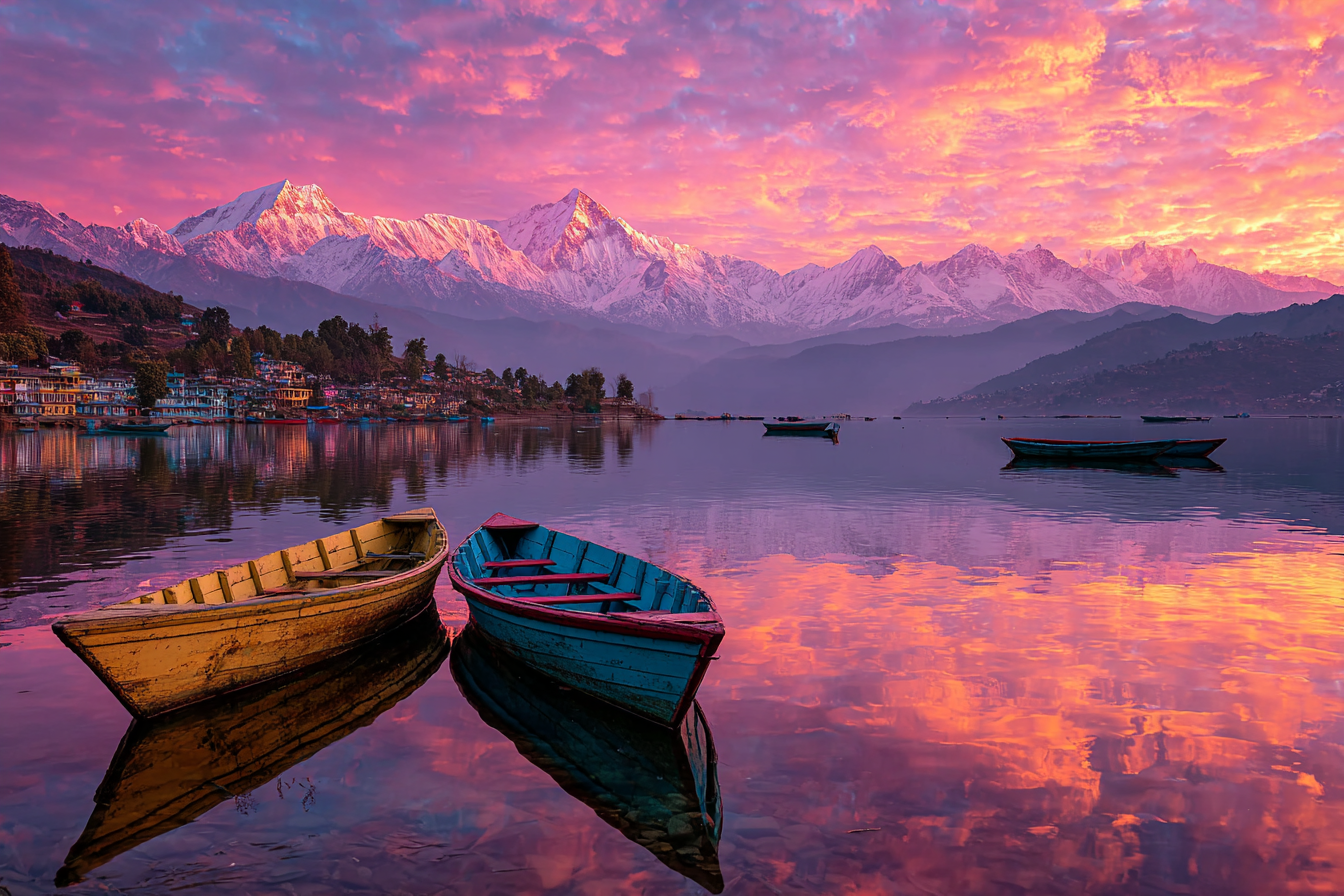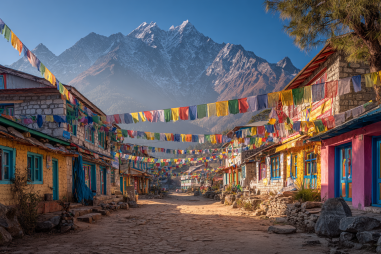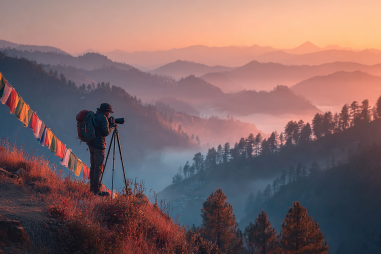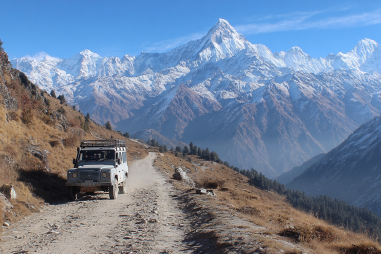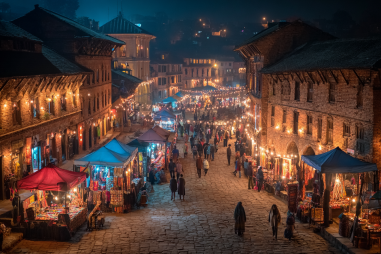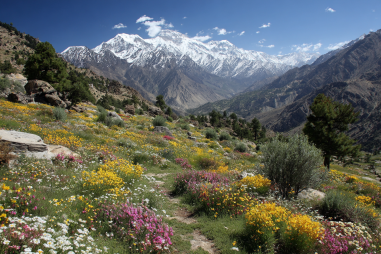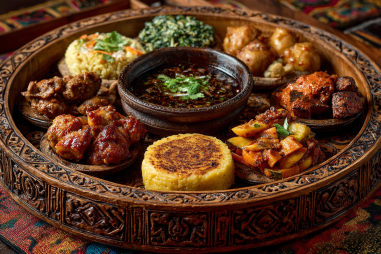Pokhara is a paradise for photographers, blending stunning natural landscapes with vibrant local culture. Nestled in the lap of the Himalayas, this picturesque city offers diverse photography opportunities, from serene lakes and majestic mountain backdrops to dynamic street scenes. Whether you’re an amateur or a professional, Pokhara’s scenic spots and cultural gems will inspire you to capture truly breathtaking shots. Let’s dive into some of the best photography locations and tips to help you make the most of your visit here.
Sunrise and Sunset Spots: Sarankot and Phewa Lake
One of the highlights of photography in Pokhara is witnessing the magical play of light during sunrise and sunset. Sarankot is arguably the most popular vantage point for capturing the sun’s golden hues illuminating the snow-capped peaks of the Annapurna range. Positioned just a short drive from the city, Sarankot offers panoramic views that are truly unforgettable. Arriving early ensures you catch the gradual awakening of the mountains and the tranquil valley below.
Another iconic location is Phewa Lake, the second largest lake in Nepal. The calm waters perfectly mirror the surrounding hills, temples, and boats, making it a top spot for photographers seeking reflection shots. Sunset by Phewa Lake creates an ethereal atmosphere, where silhouettes of fishermen and vibrant colors mix for dramatic compositions. Try different angles from the lakeshore or take a boat ride to capture unique perspectives.
Natural Landmarks: Davis Falls and Caves
Pokhara’s allure extends beyond its mountains and lakes to some remarkable natural landmarks. Davis Falls, locally known as Patale Chango, is a stunning waterfall that disappears into an underground tunnel. The dynamic movement of the water contrasted against the rugged cliffs provides excellent opportunities for capturing nature’s power. Using a slower shutter speed can help create silky water effects that add an artistic flair to your photos.
Nearby, you’ll find several intriguing caves such as Gupteshwor Mahadev Cave and Bat Cave. These caves offer an adventurous setting for photography, where the interplay of light and shadow creates moody and mysterious images. Be sure to bring a reliable flashlight or headlamp for exploring and photographing inside the darker sections safely.
Mountain Views and Panoramas
The crown jewel of Pokhara’s photographic appeal is its dramatic mountain views. The Himalayan skyline, featuring peaks like Annapurna, Dhaulagiri, and Machapuchare (Fishtail Mountain), is among the most spectacular on Earth. For wide-angle panoramic shots, spots like World Peace Pagoda or the German Cave viewpoints provide sweeping vistas that capture the magnitude and beauty of these giants.
Using a telephoto lens here can help isolate specific peaks or focus on interesting mountain ridges and patterns. Early morning or late afternoon light enhances the rugged textures and snowy caps, giving your images depth and warmth. Don’t forget to experiment with different compositions, including foreground elements such as prayer flags or blooming rhododendrons, to add context to your mountainous frames.
Cultural Scenes and Local Life
Pokhara’s charm isn’t limited to natural beauty—it’s a vibrant town teeming with culture and daily life scenes perfect for storytelling through photography. Wander the local markets where vendors sell fresh produce, spices, and handicrafts, creating a colorful and dynamic environment. Capture candid portraits of the warm and welcoming locals, traditional attire, and rituals at temples like Bindhyabasini or Tal Barahi.
Attend local festivals or everyday activities such as boat paddling on Phewa Lake or farmers at work in the terraced fields. These moments provide authentic glimpses into Nepali life and traditions. Approach respectfully, engage with your subjects, and consider using portrait lenses to highlight expressions and emotions.
Tips for Photography Gear and Timing
Preparing the right gear and timing your shoots well can significantly elevate your photography experience in Pokhara. Here are some helpful tips:
- Camera: A DSLR or mirrorless camera with interchangeable lenses offers the most flexibility, but a high-quality smartphone can also capture great images in good light.
- Lenses: Bring a wide-angle lens for landscapes and panoramas, a mid-range zoom for versatility, and a telephoto lens for distant mountain details and wildlife.
- Tripod: Essential for steady shots during low-light conditions like sunrise, sunset, and indoor cave photography.
- Filters: A polarizing filter can reduce glare on water and enhance the sky’s color; neutral density filters help achieve smooth water effects with long exposures.
- Timing: The golden hours—shortly after sunrise and before sunset—are ideal for soft, warm light. Avoid harsh midday sun, which can cause strong shadows and blown highlights.
- Weather: Clear days offer the best mountain visibility, but some mist and clouds can add atmosphere and mood to your images.
Photo Walks and Guided Tours
If you want to explore Pokhara’s photographic potential with expert insights, consider joining a photo walk or guided tour. Local guides often know hidden gems off the beaten path, best vantage points, and the perfect timing for lighting conditions. Many tours focus on specific themes such as nature, culture, or adventure photography, helping you sharpen your skills while discovering new spots.
Guided tours also ensure you get safe access to restricted areas and can learn about the cultural significance behind various sites. Plus, walking through the city with like-minded photographers is a great way to share ideas and inspiration.
Editing and Sharing Your Photos
Once you’ve captured those incredible shots, the next step is refining them through editing. Using software like Adobe Lightroom or Photoshop enables you to adjust exposure, contrast, color balance, and sharpness to bring your images to life. Maintain a natural look to preserve the authentic beauty of Pokhara’s landscapes and culture, unless you prefer a more artistic style.
Sharing your photos is equally rewarding. Utilize social media platforms like Instagram and Facebook or photography communities such as Flickr and 500px to showcase your work and connect with fellow travelers and photographers. Consider creating a photo blog or digital album to narrate your journey visually and keep memories alive.
Embracing the Magic of Pokhara Through Your Lens
Pokhara’s captivating blend of nature and culture makes it a dream destination for photographers worldwide. From the serene reflections on Phewa Lake and the dramatic ascents of the Himalayas to the lively streets and rich traditions, there’s no shortage of inspiring subjects. Whether you prefer peaceful landscapes or dynamic human stories, Pokhara offers endless opportunities to create stunning photographs that tell a compelling story. Pack your camera, embrace the adventure, and discover the timeless beauty waiting to be captured in this Himalayan gem.

